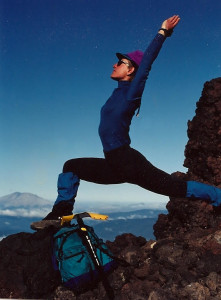STANDING POSES:
 The standing poses are invigorating. They rejuvenate the body and the mind, release tensions and pains. They stimulate digestion, kidneys, organs, improve circulation,and health of the back. Hips become stronger and stimulated, neck and shoulders gain more flexibility. Because of the vigorous nature of the standing postures, the heart and lungs are activated, helping to detoxify the blood.
The standing poses are invigorating. They rejuvenate the body and the mind, release tensions and pains. They stimulate digestion, kidneys, organs, improve circulation,and health of the back. Hips become stronger and stimulated, neck and shoulders gain more flexibility. Because of the vigorous nature of the standing postures, the heart and lungs are activated, helping to detoxify the blood.
Standing poses teach the principles of correct standing, walking and sitting. To improve energy volume in the body, the postures should be performed dynamically, with full extension of the limbs and trunk. It is important to learn how to stay relaxed even when efforting. The body has the capacity for greater range of motion, standing poses provide an opportunity to explore alignment.
Standing poses offer many benefits, not only physical but also psychological, such as Increased stability, poise, confidence, courage, and strength. The nervous system is more at ease and we feel more settled.
Suggestion: if you feel unstable or unbalanced in any standing position, shorten the stance. When the body opens and stability is developed, the stance can be wider.
TADASANA: In tadasana, the body extends upward, the base is firm and grounded, the mind is steady and attentive. Tadasana teaches centering, balance, even distribution and the direction of extensions. These principles apply to all the asanas.
VRKSASANA: tree pose which allows for a wonderful upward stretch and balance.
GURUDASANA: eagle pose, balancing pose, arms and legs intertwined.
UTKATASANA: chair pose, heels down, knees bent, trunk and arms lifting up in the opposite direction from feet, hips moving down as to sit into a chair.
UTTANASANA: extention, standing forward bend, body elongates passively.
UTTHITA TRIKONASANA: triangle is the extension of the limbs and trunk to create several triangles in the body, teaches a sense of direction and alignment.
PARIVRITA TRIKONASANA: revolved triangle, the trunk revolves full 180 degrees backward.
ARDHA CHANDRASANA: side T, standing leg is balanced, trunk is extended. extension of both legs, leg up is at hip level or higher.
PARIVRTTA ARDHA CHANDRASANA: reverse side T, the trunk turns 180 backward while balancing on one leg.
PRASARITA PADOTTANASANA I: spread out legs and feet wide apart, extend forward and down. strength, balance, extension.
PARSVOTANASA: extended sideways stretch, the trunk stretches up first then down over the front leg, hands in namaste behind the back.
UTTHITA PARSVAKONASANA: extended side stretch, knee bent to a right angle, long side stretch from the foot to fingertips.
PARIVRITA PARSVAKONASANA: revolved lateral stretch, opposite arm is locked against the bend leg, the trunk turns 180 from the front.
VIRABHADRASANA I: warrior I pose fills the body with strength and vigor.
VIRABHADRASANA II: warrior II, the trunk extends erect up over the legs, arms are reaching out to sides.
VIRABHADRASANA III: the most difficult warrior pose, firm balance and dynamism. pelvis squared, arms extended forward, balancing on one leg.